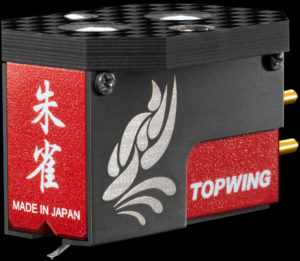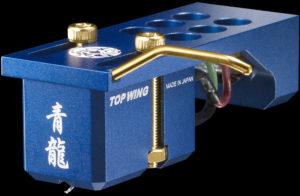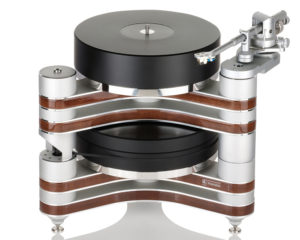When one has a phono stage as powerful and delicate as the Pass Laboratories Xs Phono, he/she is emboldened to expand his cartridge search criteria to include those with ridiculously miniscule outputs. One such example that I came across is the Top Wing Red Sparrow Suzaku at 0.2mV. Who is Top Wing?
In 2015, three Japanese high-end audio industry veterans had a meeting about bringing a revolutionary concept of a cartridge to manufacture. The three gentlemen, Hiromu Meguro, Yasuhiro Noguchi and Koichi Sasakihara, the first an inventor, the second a designer and the third a business professional, were employees of Nakamichi Corp. when a Chinese business acquired the company not long before and repositioned it as a lifestyle brand. In 2016, to continue pursuing their passion for high-end audio, the three left Nakamichi and formed the Top Wing Cybersound Group.
During their tenures at Nakamichi, Meguro and Noguchi were instrumental in the creation of the Nakamichi TX-1000 and Dragon CT, a series of highly computerized, exclusive systems of the eighties that self-centered the turntable platter to compensate for off-center LPs. Meguro is additionally famed for his Grace F9 and F8 cartridge designs in the early 1970s, two patents of which he continues to own (JPS5253404A and JPS5390903A), and enthusiasts and users of which abound to this day. From these visionary minds come two new cartridges, the $12,500 Seiryu “Blue Dragon,” and the $16,500 Suzaku “Red Sparrow,” the subject of this review.
Both cartridges feature the coreless straight-flux system to generate power. To illustrate, a line contact stylus of aluminum cantilever traces the groove, transferring movements up to a pair of left and right coils directly atop the magnet in V shape arrangement, resulting in greater fidelity. The absence of core material negates the core effect of heat buildup, which leads to energy loss. This less complex and more efficient power generation system also harnesses an additional benefit: ease in stylus replacement. Consequently, cost of stylus replacement will only cost one-tenth of the price of the cartridge! This low cost is simply unheard of in the high-end cartridge circle. The downside to this technology is the low output of only 0.2 mV.
The precision design and manufacture of the cartridges fall next to the purview of designer Yasuhiro Noguchi, who through his other position as the president of First Mechanical Design Corp., creates all the parts via the ultra-high precision laser technology of his company. Noguchi’s design expertise further made the needle, cantilever, assembled magnets, coil, damper, etc. all interchangeable between the two cartridge models, thus reducing costs of repair.
Outer-shell materials differ between the models. For the $12,500 Blue Dragon, it is endowed with a shell made of Ultra Duralumin, a lightweight alloy of aluminum and copper additionally strengthened. The result is a cartridge worthy of a flagship status and weighing over 12 grams. The $16,500 Red Sparrow, weighing in at 9 grams, then, improves upon the BD with a superior body directly adopted from advanced industries, comprising elements such as titanium, dry carbon, high-performance resins and super engineering plastics.
Still, much aspects of the Top Wing lines will remain unknown and be kept secret, such as the magnet material, compliances, etc. North America importer Joshua Masongsong of I Believe In HiFi hazarded a guess at my inquiry of the compliance at medium, and at neodymium as the magnet material. My auditioning pointed to a performance of the Suzaku more consistent with cartridges whose compliances are around 15 µm/mN, and well within the parameters of the moderate mass AMG tonearm. Tracking force was set at around 1.8 grams, well within the specified range of 1.75 to 2 grams.
The same system utilized in the Koetsu Jade Platinum review was used for this review as well, beginning with the AMG 12J2 tonearm atop the Clearaudio Master Innovation turntable with the Smart Power 24V battery power supply, Pass Laboratories Xs Phono, Xs Preamp, XA200.8 monoblocks and the Sound Lab Majestic 645 electrostatic panels. Power cables were from Audio Reference Technologies Analyst SE and Super SE, interconnects were the A.R.T. Analyst EVO and Analyst SE in both RCA and XLR terminations. Stealth Audio Cable Helios phono cable ran the signal from the tonearm to the phono stage, and A.R.T. Analyst SE speaker cables fed the speakers. The PS Audio DirectStream Power Plant 20 AC regenerator fed the system except for the power amplifiers whereby they were plugged into the wall outlets directly. All records were cleaned with the AudioDeskSysteme Glass Ultrasonic Vinyl Cleaner prior to putting under the Suzaku so as to ensure optimal tracking and removal of foreign substances that could affect the cartridge’s longevity adversely.
Costing more than the top Koetsu Blue Lace that is priced at $15,995, the Top Wing uses no platinum magnets and no silverplated copper coil wiring as the Koetsu, but it also has no core to begin with. In addition, the twin coils with the aluminum cantilever apparently require considerable burn-in, as Joshua prescribed a 75 hours minimum burn-in period, approximating ninety records in playtime. Joshua set his own Suzaku’s resistive loading at 1,000 ohms, which was where I started. Due to its low output, I set the Gain on the Xs Phono to the highest at 76 dB.
After the first side of the first record, which was a classical solo piano record from Philips, I reset the resistive loading to 100 ohms and the entire range opened up through the Sound Lab panels. Then came the 1957 stereo recording of the Tchaikovsky Symphony No. 4, from the Deutsche Grammophon box set with Yevgeny Mravinsky and the Leningrad Philharmonic, that stood assuredly and proudly despite its vintage, proving the ingenuity of the media’s creators and the treasure already contained, even in the sixty-three-year-old groove. The stereophonic effects were fully developed with exhilarating dynamics and a non-existent noise floor. The immensely sensitive and differentiating nature of the Top Wing only affirmed the quality of the recording and the pressing more firmly. Instrument groups had their individual strings and brasses expertly developed. But the 100 ohms loading also incited intermittent, rambunctious behavior from the strings. The 250 ohms setting brought the strings under control once again and imparted a textural smoothness most inducive for this recording. First verdict: The brand-new Suzaku demonstrated a higher sensitivity to loadings variance than the Koetsu.
The label’s Bach Three Concertos LP under the baton of Rudolf Baumgartner with the Festival Strings Lucern may be the most unearthly in reading but it required the 300 ohms capacitive loading on the Xs Phono for the beauty of tone to emerge unscathed. The Koetsu was kinder to this LP but the Top Wing, though more sensitive, did conjure up superior dynamic contrasting. This setting also cured the fringe but ever-present bit of excessive upper midrange energy at higher levels in Deutsche Grammophon’s piano solo recordings, rendering the piano anew, sounding more beautiful than ever through the Sound Lab panels.
- (Page 1 of 2)
- Next page →






An impeccable review of a most exciting product…however, at this time and level of things audio, semantics becomes important: the use of the word “analog” to describe the kingdom over which this new type of cartridge reign is at a fault. Except for Direct-to-Disc (with some minor qualifications), LP or Vinyl playback is not the playback of the primal analog medium but the last step in a complex transcription process that starts with an analog (or, yes, digital) tape master. As we well know, at the price levels of the remarkable cartridge being reviewed–plus price of the deserving turntable/arm combination– there are several offerings of equipment with extraodinary levels of performance for the playback of deserving music recordings in analog tape…goes without saying, the closest to primal anolog as it could be!